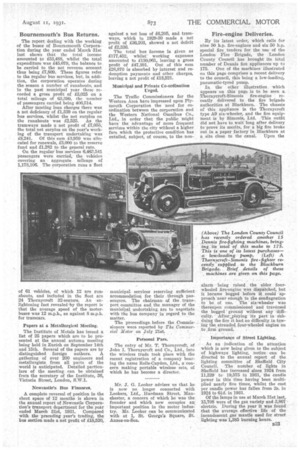Bournemouth's Bus Returns.
Page 37

If you've noticed an error in this article please click here to report it so we can fix it.
The report dealing with the working of the buses of Bournemouth Corporation during the year ended March 31st last shows that the total income amounted to £53,488, whilst the total expenditure was £45,679, the balance to be carried to the net revenue account thus being 17,809. These figures refer to the regular bus services, but, in addition, the corporation operates during the season a number of runabouts, and in the past municipal year these recorded a gross profit of £3,025 on a total mileage of 63,399, the number of passengers carried being 406,514.
After meeting loan charges there was a net deficiency of £1,339 on the regular bus services, whilst the net surplus on the runabouts was 12,525. As the tramways made a net profit of £7,055; the total net surplus on the year's working of the transport undertaking was £8,241. Of this sum £3,959 was allocated for renewals, £3,000 to the reserve fund and £1,282 to the general rate.
On the regular bus services 6,463,541 passengers were carried, the vehicles covering an aggregate mileage of 1,178,106. The corporation runs a fleet of 61 vehicles, of which 12 are runabouts, and included in the fleet ate 24 Thornyeraft 32-seaters. An enlightening fact revealed fly the report is that the average speed of the motorbuses was 12 m.p.h., as against 8 m.p.h, for tramcars.
Papers at a Metallurgical Meeting.
The Institute of Metals has issued a list of 25 papers which are to be presented at the annual autumn meeting being held in Zurich on September 14th and 15th. Several of the papers are by distinguished foreign authors. A gathering of over 200 engineers and metallurgists from all parts of the world is anticipated. Detailed particulars of the meeting can be obtained from the secretary of the institute, 26, Victoria Street, London, S.W.1.
Newcastle's Bus Finances.
A complete reversal of position in the short space of 12 months is shown in the annual report of Newcastle Corporation's transport department for the year ended larch 31st, 1931. Compared with the preceding year's trading, the bus section made a net profit of £18,520, against a net loss of £6,205, and tramways, which in 1929-30 made a net profit of £36,203, showed a net deficit of £2,336.
The total bus income is given as £177,452, whilst working expenses amounted to £130,061, leaving a gross profit of £47,391. Out of this sum £28,870 is absorbed by interest and redemption payments and other charges, leaving a net profit of £18,521.
Municipal and Private Co-ordination Urged, The Traffic Commissioners for the Western Area have impressed upon Plymouth Corporation the need for coordination between the corporation and the Western National Omnibus Co., Ltd., in order that the public might have the advantage of more frequent services within the city without a higher fare which the protective condition has entailed, subject, of course, to the non municipal services reserving sufficient accommodation for their through passengers. The chairman of the transport committee and the manager of the meniabal undertaking, are to negotiate with the bus company in regard to the matter.
The proceedings before the Commissioners were reported by Tile Commercial Motor on July 21st.
Personal Pars.
The entry of Mr. T. Thornycroft, of John I. Thornyeroft and Co., Ltd., into the wireless trade took place with the recent registration of a company bearing the name Rolls-Caydon, Ltd., a concern making portable wireless sets, of which he has become a director.
Mr. J. G. Looker advises us that he is now no longer connected with Lookers, Ltd., Hardman Street, Mancheater, a concern of which he was the founder and which now occupies an important position in the motor industry. Mr. Looker can be communicated with at 1, St. George's Square, St. Annes-on-Sea.
Fire-engine Deliveries.
By its latest order, which calls for nine 50 h.p. fire-engines and six 50 h.p. special fire tenders for the use of the London Fire Brigade, the London County Council has brought its total number of Dennis fire appliances up to 175. One of the machines illustrated on this page comprises a recent delivery to the council, this being a low-loading, pneumatie-tyred pump.
In the other illustration which appears on this page is to be seen a. Thornycroft-Simonis fire-engine recently delivered to the fire brigade authorities at Blackburn, The chassis of this appliance is the Thornycroft type Al) six-wheeler, and the fire equipment is by Simonis, Ltd. This outfit did not have to wait long after delivery to prove its merits, for a big fire broke out in a paper factory in Blackburn at a site close to the canal, Upon the alarm" being raised the older fourwheeled .fire-engine was dispatched, but it became bogged before it could approach near etiough•to the conflagration to be of use. The six-wheeler was thereupon commissioned and traversed the bogged grOund without any 'difficulty. AfterLpIaying its part in iubtitling the fire it had no difficulty in towing the stranded four-wheeled engine on to firra ground.
Importance of Street Lighting.
As an indication of the attention which is now being given to the subject of highways lighting, notice can be directed to the annual report of the lighting committee of Sheffield City Council. The number of lights in Sheffield has increased since 1924 from 11,329' to 19,575 in 1931, the candle power in this time having been multiplied nearly five times, whilst the cost per candle power has fallen from 2s. in 1924 to 6id. in 1931.
Of the lamps in use at March 31st last, 15,708 were of the gas variety and 3,867 electric. During the year it was found that the average effective life of the incandescent gas mantle used for street lighting was 1,385 burning hours.




























































































